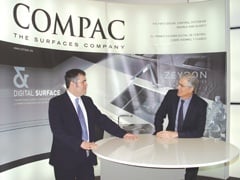Surfaces : Compac
Vanille and Café are the latest colours in Compac quartz, designed to complement each other. They were introduced to the UK last month at the KBB exhibition. Afterwards, Erik Schoneveld, who heads Compac’s R&D department, told NSS why innovation is the essence of Compac’s marketing philosophy.
If you want water, you just touch the worktop in the new Café colour from Compac next to the sink. Touch it again to increase the flow. Touch another place and the water gets hotter or colder. But if you touch the controls with something other than your finger (water or a cup, for example) nothing happens.
There are no wires going up through the worksurface, just a sensor stuck underneath that responds to the specific change in electrical charge that results from touching the surface with your finger and not the change resulting from touching it with anything else. It can be timed so the tap turns itself off after a specified period to save water. The same technology could be used to control the temperature of hobs and ovens, lighting, the TV, or anything else that can be operated electronically. All you have to do is touch the right place on your worktop.
The electronic wizardry intriguing visitors to the Compac stand at KBB in the NEC, Birmingham, last month came from Zeyron Technologies. Compac were hoping visitors would notice the worktop in the new Vanille and Café colours that the controls were on while they experimented with the tap controls, as well as subliminally absorbing the message that Compac is the high-tech, modern surface for the kitchen a la mode.
It is a message not easy to convey by showing a worktop, but it is not for nothing that the quartz and marble composite surfaces Compac make in Portugal and Spain, respectively, are known as ‘engineered’ stone.
And the engineering continues under the direction of Erik Schoneveld, who heads Compac’s research & development department in Spain.
Compac’s quartz worktops are made by mixing 90-95% unadulterated crushed quartz mineral with resin and pigments. It is compacted in a vibration press that removes all air from the mix then passed through heaters to cure before being polished.
The process for making quartz was developed by the Italian machinery company Breton, who sell the lines for its production. Quartz Compac is made in 12, 20 and 30mm thickness.
Marble surfaces use larger pieces of rock with the resin and are formed as blocks, which, after curing, are sawn and polished in the same way as a block of stone.
The process is essentially the same whoever is making the slabs, which can lead to the idea that all engineered stone is much the same. But it is not – and it is an indication of how much variation there can be that the makers restrict access to their plants and will not allow photographs to be taken of parts of their processes.
Even saying Quartz Compac is made by mixing quartz with resin and pigment is misleading because it gives the impression the ingredients are all standard products, which they are not.
As Erik Schoneveld points out, there are many different kinds of polymer matrix resins available and they are being developed all the time. What the quartz composite makers are looking for is a resin that has long, three-dimensional molecules giving high rigidity and abrasion resistance without being brittle, which would make the surface prone to chipping. At the same time the surface has to have high resistance to heat and acid attack if it is to be usable in a kitchen.
If there is a wide range of resin, there is an even greater choice of pigments. There are more than 50 colours in the Compac range and the company want all of them to be colour-fast, although some pigments are more susceptible to bleaching by sunlight than others. Compac do produce engineered stone with pigments that retain their colour in sunlight and are widely used for exteriors in France, Belgium and northern Spain.
There are also other ingredients and processes that the makers like to keep to themselves. Erik says Compac are currently working on a range that looks more like natural stone but with the colour consistency that is one of attractions of quartz composite to many designers. It is one of the roles of Erik’s department to develop new ranges and put them into production. It is demanded of a designer product that there is always something new to differentiate it from the rest.
“We’re always innovating and trying to be on the edge of design, quality and environmental improvements,” says Erik.
The point about environmental improvements is also mentioned by Ignacio Gómez-Ferrer, Compac’s newly appointed Europe Export Manager. He believes the environment, along with design innovation, are advantages European manufacturers have over low price competition from the Far East. European consumers are increasingly conscious of the environmental impact of their purchases and want to reduce it. And it is not just transport with its associated greenhouse gas emissions that need to be considered. Resin is a product of the petro-chemical industry that can be environmentally damaging, which is reflected in European production methods.
Compac Quartz and Marble ranges are available in the UK from Compac’s own warehouses in Heston, near Heathrow, and Wakefield, Yorkshire, as well as from London stone wholesalers MGLW.

